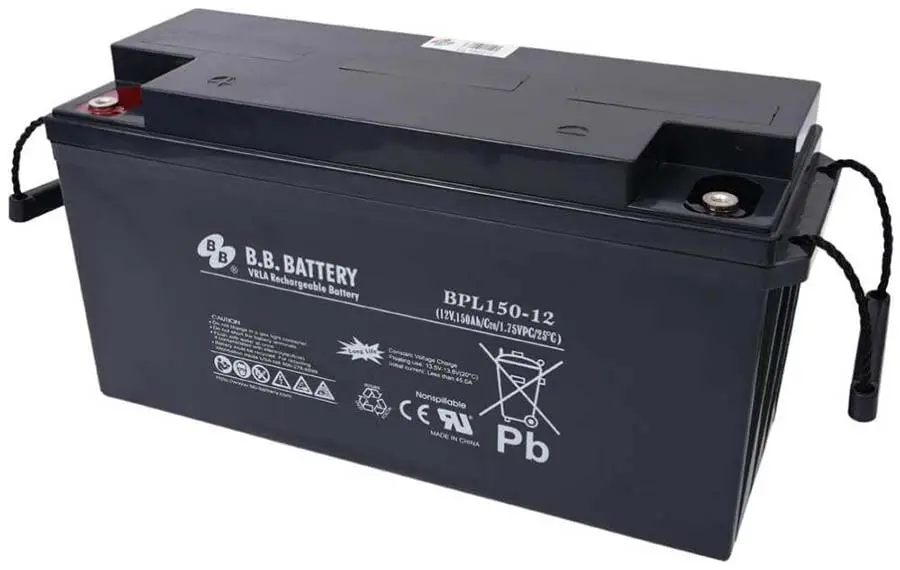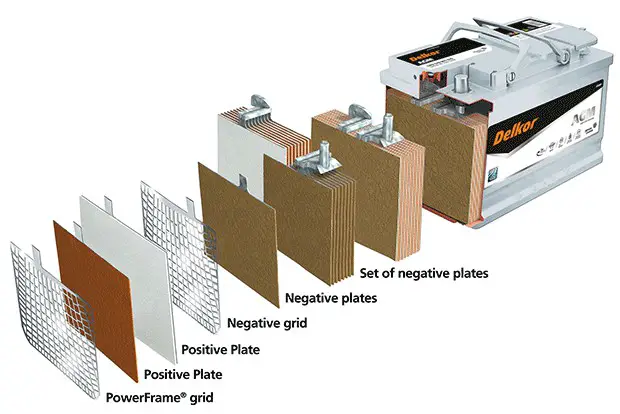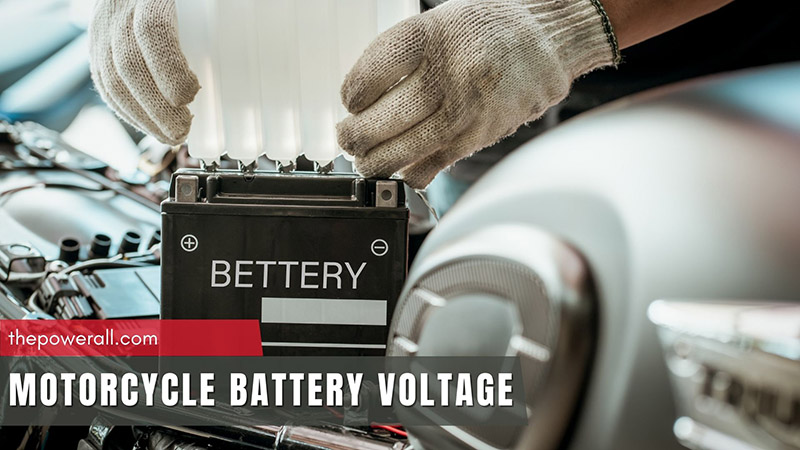Although much easier to maintain and use than car batteries, motorcycle batteries still demand meticulous attention and a keen sense of observation.
Failure to charge your battery on time will lead to more costly repairs (or worse, entire bike replacements) than you could ever imagine!
So what is the motorcycle battery voltage? Keep scrolling for our take on the matter.
Battery Voltage for Motorcycle: How Many Volts Are Motorcycle Batteries?
1. What Voltage Battery Is In A Motorcycle?
12V batteries are definitely the most common in motorbikes – and even other vehicles like ATVs, RVs, cars, or boats. Despite coming in numerous sizes, their cube shapes are similar.
Like their counterparts in other automobiles or household equipment, the 12V battery motorcycle does not produce energy or power on its own. Instead, they store a certain amount of built-in power to channel it across the bike system.

A voltmeter should tell you how much battery voltage your bike has, whose readings fluctuate between 0 and 24. A 100% functional and healthy battery should read approximately 12.6.
2. How To Know Whether Your Bike Uses 12V or 6V Batteries?
6-volt batteries indeed exist, but they are so rare that not many consider them an option. These old-model batteries mostly thrive in dirt and vintage bikes, whose primitive systems do not demand 12V battery operations.
The important question is, how can you know whether a specific bike has 6V or 12V batteries? Here are two methods for checking:
a. Refer to your instruction manual:
Definitely the best and most efficient method. You only have to open the manual, go to the “Specs” section, and scan through the pages until you spot the voltage.
b. Open the motorbike’s seat to read the specs:
What if, for some reason, you cannot access the manual? Riders throwing their manuals away or misplacing them are not uncommon. In that case, you have another option: do the checking manually!
Step 1. Locate the bike’s ignition switch. Turn it to “OFF.”
Step 2. Remove your motorbike seat:
- Loosen the bolts
- Yank the seat backward and up
- Pull it off the motorcycle
Step 3. Once you get the seat out of the way, the battery can be seen clearly. Scan through its shell for the specs – where amp-hour rates and voltages are mentioned.
In some cases, riders still fail to see the data clearly for certain motorcycles due to the battery’s installment. The only thing left is to pull the battery off the bike as well.
Quite laborious, we know; that’s why keeping your manual is important!
Different Battery Voltages: How to Interpret Them?
- Overcharged (Unhealthy): Anything beyond 12.9V signifies an overloaded motorbike filled to the brim with excessive battery power. Stop the charging before it brings about permanent damage!
- Fully-Charged (Healthy): Readings from 12.6V to 12.8V is good news; your bike is ready to launch you into long-distance trips.
- Charging Might Be Needed: 12.06V to 12.62V equals 50% to 90% capacity. The power left is still enough to handle several more miles, though some more charging certainly doesn’t hurt.
- Charging Is A Must: Any number below 12.06V is alarming; your bike is running on less than 50% battery. The lower your battery life is, the more chances of battery failures there are, which is why you MUST charge it immediately.
- Replacement Is A Must: You must have neglected the battery for quite some time if it reaches 10.5 (or worse, even lower). There’s no point in registered charges now; it’s a dead battery already. Replacements will be the only choice left for you.
Keep tabs on your bike often, especially if it has been on the run for several years. Natural causes worsen the battery’s charging and recharging capabilities over time, and the risks of defective batteries are now on the horizon.
Types of Motorcycle Batteries and How to Charge Them
1. Lead-Acid, Wet Cell Batteries
Wet-cell batteries have been around for ages and are considered the basic battery type for every automobile. True to their names, these batteries comprise liquid-electrolyte cells (filled with sulfuric acid), which play a critical role in the entire charging process.

Pros
- Easy top-off and maintenance
- Easy charging; no need for smart chargers
- Withstand charges of higher voltage than their AGM counterparts
- Robust, not easily affected by voltage levels
Cons
- Heavier than AGM
- Low-performance
- Charge-holding abilities are weaker than AGM, especially after being unused for long periods of time
- Liquid electrolytes respond poorly to changed positions (tilted away from verticals) and vibrations.
- Corrosion risks due to sulfuric
- Explosion dangers due to hydrogen gas
As you can see, the cons far outweigh the pros, which is partly why wet-cell batteries only thrive in stable platforms or large vehicles with spacious housing now. (ex: cars, trucks, etc.).
Their presence in motorcycles has reduced over time, and using them for dirt or sports bikes is simply a big no.
Charging Tips
Several rules to remind yourself when charging wet cells:
- Its amperage must be 10-11% of the total hour/amp rating. For illustration, a battery with a 14 hour/amp rate must be charged and ignited at about 1.4 amps.
- Smart chargers are great but not necessary. Using old-school, vintage chargers like Constant Current or Direct Current will be acceptable.
However, unlike smart chargers, they keep sending charges till you disconnect them. Without proper monitoring, your battery might get damaged.
2. AGM Batteries
AGM (absorbent glass mats) is another lead-acid battery, like wet cells. The major difference is that it utilizes fiberglass matting – hence its name – to store and absorb sulfuric acid electrolytes. Such designs gain the batteries better efficiency and spill-resistance.

These battery versions continue to be broken down into two types:
- Batteries with no electrolyte; one must add the electrolyte to the cells himself
- 100%-sealed, factory-approved battery that requires zero maintenance
Pros
- High-performance, withstanding low temps well
- Holding charge much better than wet cell
- Less vulnerable to self discharges
- Lighter and smaller than wet cells
- Sealed batteries are open to various angled installations, posing zero risks of hydrogen gas or corrosion
Cons
- Much pricier than wet cells
- Smart chargers are a must
Their lightweight and compact form requires no need for stable platforms, making them an all-time favorite power source for modern bikes, dirt bikes, sport bikes, and ATVs – the complete opposite of wet-cell batteries.
Charging Tips
The high performance and impressive durability come at a cost: these batteries are very demanding and specific during their charges:
- The charge MUST never surpass or dip below the manual’s required level. Even a slight over-charging instance will shorten AGM’s lifespan and lead to quick damage. It would be best to use “slow and low” systems that will taper off once the charges get closer to completion.
- As just mentioned, AGM batteries cannot do without smart chargers. Thankfully, since low-current charges are already sufficient, there’s no need to spend money on exorbitant chargers that can deliver high amperage.
Simply calculate the charging time required for your brand-new battery by applying the number to this formula: Hours = Amp Rate / Amp Charge.
For instance, let’s say your bike uses Yuasa YTX14 batteries with an amp/hour rate of 14. One 1-amp charging session will take you 14 / 1 = 14 hours.
- Want to speed up the charges, especially for new batteries that just got activated? Simple: increase their charge amps. But since we just said AGM works better with “slow and low” systems, it would be best to engage the lowest amperage possible.
- Manufacturer-sealed batteries should arrive 100% charged. You can confirm using battery testers – whose readings should be approximately 12.6 to 12.8 volts.
Extra: Gel Batteries (Lesser-Used)
AGM and wet cells are the most dominant in motorcycles (the latter’s decline in popularity doesn’t throw it off the relevance chart). Still, in case they are not within your budget, take a closer look at these decent alternatives: gel batteries.

Gel-filled batteries often arrive in gray, blue, or back casing with correspondingly-themed tops. As the gel barely moves around, these batteries work better lying at angles or on their sides.
Also, the more pressure there is, the better – since gel acid requires a mixture of hydrogen and oxygen for optimal circulation.
There’s no need for topping off since the state acids have already been sealed 100% during manufacturing. More specifically, the fumed silica (commonly known as the gelling agent) encases the electrolytes, ensuring their state is always maintained.
Charging Tips
- No need for smart chargers, though it would be great if you have one.
- For regular battery chargers: Keep tabs on the battery during 7-12 hours of charging to guarantee the output never exceeds 12.9V. Remove the chargers after your battery exceeds 95%.
How to Check The Battery Voltage

Our previous sections have briefly mentioned how to monitor the voltage readings to confirm when to charge and discharge the bike. Here, let’s discuss in detail how to do that:
1. With Battery Tester
Step 1. Turn off the headlights and ignition, then open the car hood to find the battery
Step 2. Set up the digital voltmeter to DCV or DC. If the device has a voltage range, set it at 20V
Step 3. Connect each probe to its appropriate battery terminal (positive cable – positive terminal; negative cable – negative terminal) and check the reading.
2. Without Battery Tester
Do it the traditional way: ask a friend to start the car in Park mode with brakes on. Observe the headlights: do they look dimmer as your engine starts? If yes, chances are the battery suffers from insufficient charges.
What to Do If The Motorcycles Battery is Flat or Dead?
As we already discussed, replacements are your only choice; a flat battery is beyond saving!
But what if the battery dies/ goes flat in the middle of an empty road, and you don’t want to call a towing service? Consider jump-starting the vehicle using starter packs, bump starts (for downhill roads), or another car/motorbike if its owner is willing to lend you a helping hand.
What Is The Life of A Motorbike Battery? How to Extend Its Lifespan
About two to five years – not bad, considering their affordable prices! Are there tips to ensure 100% full charged 12V motorcycle battery voltage to last longer? Sure, they entail:
- Cleaning the terminals regularly
- Tightening loose connectors
- Topping up the electrolyte via distilled water
FAQs
Is 12.4V Okay for Motorcycle Batteries?
Yes; your battery is still more than 50% full.
Is 11.9V Good?
No. While this bad battery isn’t dead yet (and you should thank it for that!), its less-than-50% capacity requires charges immediately.
Conclusion
While certain differences in battery maintenance can be detected across each bike model and battery type, this one-size-fits-all guide should cover about 90% of the most common scenarios. Should our tips fail to apply to your battery issues, feel free to leave suggestions below or ask us for advice.









0 Comments